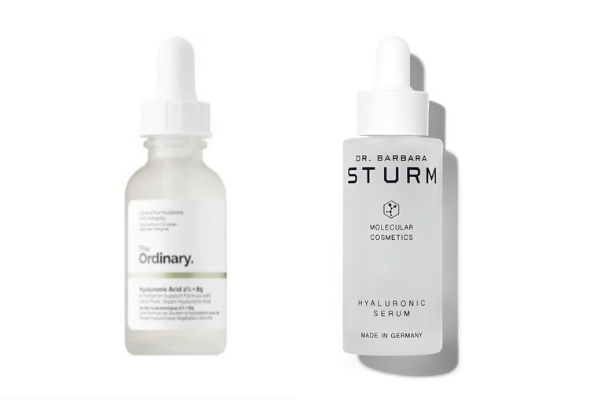Hyaluronic acid is a skin care ingredient that isn’t going anywhere soon.
The trendy beauty staple is said to hydrate, plump and protect the skin from moisture loss, and is the key ingredient in products from drugstore and budget-friendly brands like Neutrogena ($21) and cult favorite The Ordinary ($7) to prestige lines like Dr. Barbara Sturm, a brand that sells a 30 ml bottle of hyaluronic acid serum for $300.
With all of the hype around this moisture-boosting ingredient, consumers find it challenging to understand which products give the best results. But thanks to beauty communities on Reddit, Makeup Alley and Sephora message boards, skin care lovers can share what is and isn’t working for them.
One of the top questions on the message boards discussing hyaluronic acid is, “Is it worth it?” Does it really make a difference whether you purchase a $7 product or upgrade to a $300 serum? We talked to dermatologists to find out.
What is hyaluronic acid, anyway?
“Hyaluronic acid is a natural sugar found in our skin,” said Joshua Zeichner, director of cosmetic and clinical research in dermatology at Mount Sinai Hospital in New York. “It is what provides bounce and plumpness to the skin. Think of it like the stuffing in your mattress. As a humectant, hyaluronic acid is essentially a sponge that binds to 1,000 times its weight in water.”
Even though the humectant is a powerhouse, that doesn’t mean it can do it all.
When it comes to fully moisturizing and plumping your skin, “hyaluronic acid alone might not do the job,” said Victoria Fu, who is half of the chemist duo at skin care brand Chemist Confessions. “Look for products that pair with other types of hydrators such as glycerin, glycols, urea, panthenol, sodium PCA, etc. One ingredient won’t solve all your moisturizing troubles — skin hydration is a team effort.”
Why are some hyaluronic acid products so expensive?
What drives up the cost of hyaluronic acids? A few things: molecular weight, added ingredients and product packaging.
“There are some studies that suggest smaller molecular weight HA can penetrate somewhat better and can have long-term anti-aging benefits on top of hydration,” Fu said. The Ordinary’s $7 HA formula combines low, medium and high molecular weight hyaluronic acid, while Dr. Sturm’s $300 HA uses short- and long-chain molecules (low and high weight). For those of us who weren’t paying attention in chemistry class, Zeichner kindly breaks the science down for us.
“Smaller molecules can better penetrate through the outer skin layer to give more of a plumping effect,” Zeichner told HuffPost, explaining that the smaller molecules can go deeper into the skin. “Long-chain HA, because of its large size, does not penetrate well through the skin and provides a hydrating effect to the outer skin’s layer.” Zeichner says many over-the-counter products stick to high and medium molecular weights because “there is some data that low molecular weight HA may actually promote inflammation in the skin.”

Fu told HuffPost that molecular size “can certainly drive up the cost of the product. However, it also heavily depends on concentration, support ingredients or any sort of special testing that was done on the HA product.”
Does the percentage of HA in a product play a role in pricing, like it does with retinol, glycolic acid and vitamin C?
“Most products are not listing the specific concentrations of ingredients on their packaging,” Zeichner explained. But products like Ghost Democracy have 2.1% HA, which Zeichner said “is among the highest concentrations on the market ― the majority of products contain around 1% HA.”
But Lu, the other co-founder of Chemist Confessions, said, “HA is not an ingredient that needs to be in the formula at a super high concentration. 0.2% is usually solid, and by 1%, your formula is going to end up as a solid chunk.”
With all of this scientific information in mind, can a $7 hyaluronic acid perform as well as a $300 HA?
“It’s hard for us personally to shell out $300 for a hyaluronic acid serum,” Lu and Fu told HuffPost. Speaking to the Dr. Barbara Sturm product, they said, “While having exotic antioxidants like purslane can certainly make it more effective than the average economical HA product, we’re just not sure it’s $300-worth effective.”
Michelle Wong, a chemist behind the blog Lab Muffin, uses her social media platforms to share the science behind product development while giving tips on which products are worth buying. Wong agrees that “hyaluronic acid products do not need to be very expensive,” adding, “the pricing of almost all beauty products are based on marketing and consumer perception rather than the actual cost of ingredients.”
But Lu recommends “looking for products that have gone through actual clinical testing” if you are in the market for a prestige-priced HA. “Clinical testing means that a brand paid to test their product on a group of subjects with a third party clinic and take measurements to show actual efficacy. We think this is a great and meaningful way to substantiate marketing claims,” Fu told HuffPost.
Lucky for us, hyaluronic acid seems to be an accessible skin care ingredient that will benefit your routine no matter the price point.
